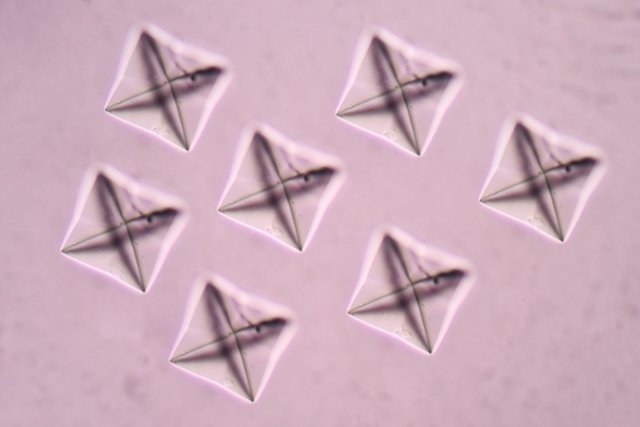Calcium oxalate crystals are small masses that can be found in neutral to acidic urine. It can be a normal finding in the urine if the patient does not present with any other signs or symptoms.
These crystals may appear due to decreased water intake or a diet rich in calcium and oxalate.
These crystals have an envelope-like shape, and are identified through microscopy in the lab with a urine R&M test. In addition to calcium oxalate, other crystals may also be noted, like triple phosphate, leucine and uric acid.

What causes calcium oxalate crystals in the urine?
The main causes for calcium oxalate crystals in the urine are:
1. Changes to diet
Some changes to your daily diet can lead to the formation of crystal oxalate crystals in the urine. This can especially happen with a high-calcium diet from eating foods like tomato, spinach, rhubarb, garlic, orange and asparagus. These crystals can also form with excessive intake of vitamin C (above the recommended dose), or decreased water intake throughout the day. Not drinking enough water can lead to more concentrated urine, which can promote the formation of crystals that are identified during a urine test.
Treatment: Although the presence of crystal oxalate crystals in the urine is not of serious concern, it is important to increase your water intake and adjust your diet if they appear in the urine. With certain diet changes, you can actually decrease your risk for developing kidney stones. You should also increase your intake of fruits, vegetables and whole grains, as well as reduce your salt intake.
2. Kidney stones
Kidney stones are a very uncomfortable condition characterized by the presence of hard, stone-like masses in the urinary tract. They are often identified through a urine R&M test, and can be made-up of calcium oxalate. These stones are more prone to develop as a consequence of a diet high in calcium, sodium and protein.
Kidney stones usually cause immense pain and discomfort that is particularly felt in the lower back. Other common symptoms include difficulty urinating, burning when urinating and red or pink urine. Stones can block off urinary flow, causing obstruction and inflammation.
Treatment: If you are unable to urinate, you should proceed to the hospital for immediate treatment. Treatment will depend on the location, size and amount of stones present. Generally, a urologist or nephrologist may prescribe medication to relieve pain and promote elimination of the stone.
Kidney stones that are very large and cannot be eliminated through the urinary tract may require a small surgical procedure for removal. Learn more about what causes kidney stones and how they are treated.
3. Diabetes
Diabetes can cause many different changes to the urine. Some diabetic patients may present with crystal oxalate crystals in the urine, especially if the condition is not well-managed and under-control.
In addition to these crystals, diabetic patients may also present with glucose, bacteria or yeast in the urine. Diabetics with poor control of this condition are at a higher risk for developing a UTI due to increased glucose concentrations, which promotes microorganism proliferation.
Treatment: It is important for diabetes to be managed as directed by a doctor or endocrinologist. Keeping glucose levels within normal ranges can help to prevent complications. Treatment of diabetes typically involves medications to help control blood sugar levels, which you can learn more about here, as well as a healthy diet and regular physical activity.
Check out other tips for lowering your blood sugar and keeping diabetes under control.
4. Liver problems
Liver problems can also promote the formation of crystal oxalate crystals in the urine. Changes in the liver may also cause bilirubin and hemoglobin to appear in the urine. See which symptoms of liver disease you should not ignore and should report to your doctor.
Treatment: In this case, it is important to see a liver specialist or family doctor for a thorough assessment so that the liver problem can be identified. Once confirmed, the most appropriate treatment can be initiated as necessary.
5. Kidney disease
Kidney problems, like an infection, inflammation or failure, can lead to the appearance of crystal oxalate crystals in the urine. Changes to kidney function can interfere with the filtration and reabsorption processes, which can promote the formation of crystals. Check out the symptoms of kidney disease that you should look out for.
Treatment: It is important for the doctor to order testing to assess kidney function, so that other changes in addition to the crystals can be identified. Treatment as appropriate should be initiated to prevent further damage to the kidneys.
Read more about crystals in urine, why they happen and the types of symptoms that can emerge.
